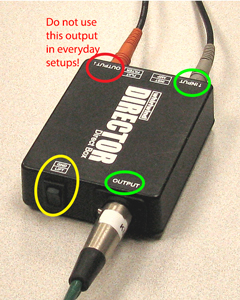Direct (DI) Boxes
Basic Information
DI stands for "Direct Input". A direct box changes the impedance of a signal from instrument level (+4dB) to microphone level (-12dB).
The KUB primarily uses passive direct boxes. These do not require a separate power supply or phantom power. Passive DI boxes are used for large scale sound reinforcement in order to keep an instruments volume at one level in order to balance it with other instruments.
Setup Considerations
IF YOUR CONNECTIONS LOOK LIKE THIS, YOU DID IT WRONG!

When using a DI box to connect a phone or another device that requires combining a stereo signal into mono, USE AN ADAPTER TO COMBINE THE STEREO SIGNAL FROM THE DEVICE.
Plugging one of the cables into the DI box's 1/4" INput jack (gray cable, picture left), and plugging the other cable into the DI box's 1/4" OUTput jack (red cable, picture left) does not solve the problem! All this technique accomplishes is transmitting ONLY ONE side of the audio (in this case the left channel of a stereo signal) to the sound system. The other side of the audio signal (in this case the right channel of a stereo signal) is completely lost and will not be heard.
When setting a DI box for a large performance, connect the XLR (mic) cable to the DI box, and place a 1/4" instrument cable next to or on top of the DI box. Test the mic cable connection by unplugging the DI box and connecting a microphone. If the mic connection/cable works, then re-connect the DI box. If it does not work, a new cable will probably need to be run. If multiple DI boxes are used on stage for the same event put a piece of white board tape on the DI box with the mic input number written on the tape.
Switches & Connections
- INPUT (1/4” jack) - For input of the signal from the source. The source may be the output of any type of musical instrument or amplifier speaker output. (WARNING! In speaker mode, the Director does not supply the proper amplifier load required by most tube type amplifiers. Do not use a tube amplifier’s speaker output alone with the Director. You must also have a speaker or appropriate dummy load connected to avoid possible damage to the amplifier.
- OUTPUT (1/4” jack) - A “Y” connection or “loop through” from the input.
- OUTPUT (XLR jack) - A male XLR, provides a balanced low impedance (150 Ohms) signal for connection to balanced, low-Z equipment (mixing console, workstation, etc.)
- INST/AMP (Switch) - Most instruments will operate properly when set to the INST position. Set to the AMP position for use with very “hot” instrument signals or when connecting the Director to the speaker output of an amplifier.
- FLAT/FILTER (Switch) - Engages a high-cut filter when used in the FILTER position to reduce hiss and noise. This filter is functional only when the INST/AMP switch is in the AMP position. Filter is bypassed when set to the FLAT position.
- GND/LIFT (Switch) - Disconnects the ground between the input and the XLR output when set to the LIFT position to help eliminate hum. Ground remains connected when set to the GND position.
Troubleshooting
Humming or buzzing can usually be solved (on the Whirlwind Directors (Manual) and laptop DI boxes) by activating or de-activating the ground by using the ground lift rocker switch (yellow circle, picture left).
See also 1/4" Instrument cable Vs. 1/4" speaker cable.
